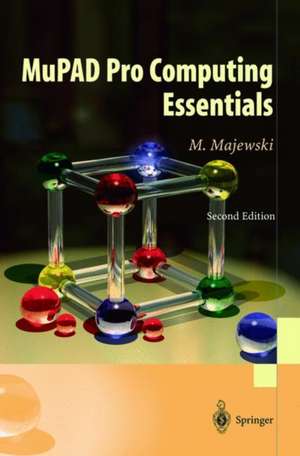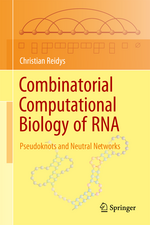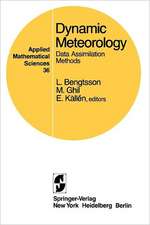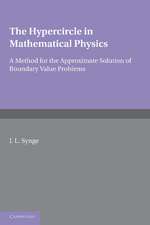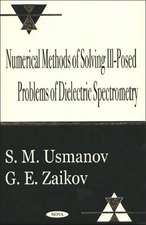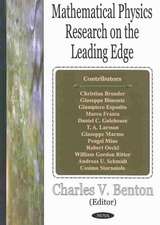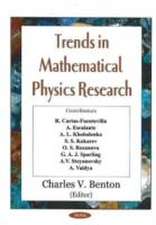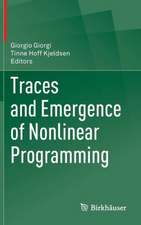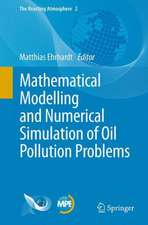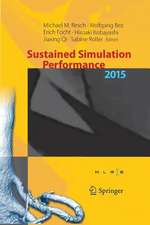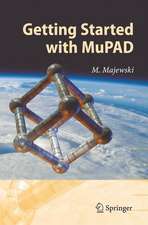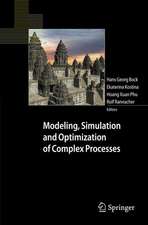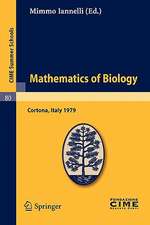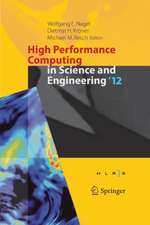MuPAD Pro Computing Essentials
Autor Miroslaw Majewskien Limba Engleză Paperback – 21 mai 2004
Preț: 406.05 lei
Nou
Puncte Express: 609
Preț estimativ în valută:
77.70€ • 81.33$ • 64.67£
77.70€ • 81.33$ • 64.67£
Carte tipărită la comandă
Livrare economică 01-15 aprilie
Preluare comenzi: 021 569.72.76
Specificații
ISBN-13: 9783540219439
ISBN-10: 3540219439
Pagini: 556
Ilustrații: XI, 538 p. 921 illus.
Dimensiuni: 155 x 235 x 29 mm
Greutate: 0.84 kg
Ediția:2nd ed. 2004
Editura: Springer Berlin, Heidelberg
Colecția Springer
Locul publicării:Berlin, Heidelberg, Germany
ISBN-10: 3540219439
Pagini: 556
Ilustrații: XI, 538 p. 921 illus.
Dimensiuni: 155 x 235 x 29 mm
Greutate: 0.84 kg
Ediția:2nd ed. 2004
Editura: Springer Berlin, Heidelberg
Colecția Springer
Locul publicării:Berlin, Heidelberg, Germany
Public țintă
ResearchCuprins
1.1 For whom this book was written.- 1.2 The goal.- 1.3 Why we should care about MuPAD.- 1.4 What is inside.- 1.5 Style conventions.- 1.6 Writing “between”.- A Quick Introduction to MuPAD.- 2.1 The Very First Look.- 2.2 Getting Started.- 2.3 A Quick Look at MuPAD’s Interface.- 2.4 Formatting Documents in MuPAD.- 2.5 Getting Help.- 2.6 Chapter Summary.- 2.7 Review Exercises.- Programming in MuPAD — Declarations.- 3.1 Writing Formulae in MuPAD.- 3.2 Declaring Variables and Constants.- 3.3 Declaring Functions and Operations.- 3.4 Writing More than One Line of Code.- 3.5 The Basics of the Domain Concept.- 3.6 Chapter Summary.- 3.7 Review Exercises.- Programming in MuPAD — Control Structures.- 4.1 Decisions.- 4.1.1 MuPAD Syntax: the “if” Statement.- 4.1.2 Indentation in MuPAD.- 4.1.3 Quadratic Equation Example.- 4.1.4 Formatting Output and Input.- 4.1.5 “elif” a Useful Shortcut.- 4.2 Programming Itcrations in MuPAD.- 4.2.1 The “for” Loop.- 4.2.2 MuPAD Syntax: the “for” Loop.- 4.2.3 The “while” and “repeat” Loops.- 4.2.4 MuPAD Syntax: the “while” and “repeat” Loops.- 4.3 What is Wrong with my Loops and Conditions.- 4.4 Selections.- 4.4.1 MuPAD Syntax: the “case” Structure.- 4.5 Chapter Summary.- 4.6 Programming Exercises.- Programming in MuPAD — Procedures.- 5.1 What is a Procedure.- 5.2 Examples of Procedures.- 5.3 Getting Output from Procedures.- 5.4 Returning Unevaluated or Symbolic Expressions.- 5.5 Shall We use Global or Local Variables?.- 5.6 Introduction to Types and Domains.- 5.7 Using MuPAD Types and Domains.- 5.8 Using Procedures to Produce Data Structures.- 5.8.1 Sequences.- 5.8.2 Lists.- 5.8.3 Sets.- 5.8.4 Strings.- 5.8.5 Vectors and Matrices.- 5.9 Procedures with a Variable Number of Input Parameters.- 5.10Recursive Procedures.- 5.11 Using Libraries.- 5.12 User Defined Libraries of Procedures.- 5.13 Final Comments on MuPAD Coding Guidelines.- 5.13.1 Magic Numbers.- 5.13.2 Comments.- 5.13.3 Braces.- 5.14 Chapter Summary.- 5.15 Programming Exercises.- to MuPAD Graphics.- 6.1 Obtaining Quick Plots.- 6.1.1 Procedure plotfunc2d.- 6.1.2 Your First Animation with MuPAD.- 6.1.3 Procedure plotfunc3d.- 6.2 General Concept of MuPAD Plots.- 6.2.1 Object Attributes’ Options.- 6.3 Canvas, Scene and Coordinate System Options.- 6.3.1 Options for Canvas.- 6.3.2 Options for Scene2d.- 6.3.3 Options for Sccnc3d.- 6.3.4 The Coordinate System in 2D and 3D.- 6.4 Options Related to Primitives.- 6.4.1 Basic Options for Primitives.- 6.4.2 Working with Color.- 6.4.3 Mesh and Other Options.- 6.5 Operations on Graphical Objects.- 6.5.1 Operation modify.- 6.6 Chapter Summary.- 6.7 Programming Exercises.- Interactive Graphics’ Animation with VCam.- 7.1 Learning the Virtual Camera Environment.- 7.2 Using VCam to Improve 2D Graphs.- 7.3 Using VCam to Improve 3D Graphs.- 7.4 Interactive Development of Animations.- 7.5 Saving MuPAD Graphs.- 7.6 Chapter Summary.- 7.7 Exercises.- Exploring Mathematical Curves and Surfaces.- 8.1 Plots in 2D Space’ Plot Types.- 8.1.1 Class Function2d.- 8.1.2 Class Curve2d.- 8.1.3 Developing Polar Plots.- 8.1.4 Developing Implicit Plots.- 8.2 Plots in 3D Space.- 8.2.1 Class Function3d.- 8.2.2 Class Surface.- 8.2.3 Class Spherical.- 8.2.4 Class Cylindrical.- 8.2.5 Class Implicit3d.- 8.2.6 Classes Curve3d and Tube.- 8.3 Chapter Summary.- 8.4 Programming Exercises.- A Few Applications of MuPAD Graphics.- 9.1 Calculus Graphics.- 9.1.1 Plotting Contours.- 9.1.2 Developing Density Plots.- 9.1.3 Vector Fields.- 9.1.4 Plotting Areas.- 9.1.5 Surfaces of Revolution.- 9.2Presentation Graphics.- 9.3 Working with Geometry Objects.- 9.4 Transformations of Graphical Objects.- 9.5 Turtle Graphics & L-systems.- 9.5.1 Turtle Graphics in MuPAD.- 9.5.2 Plotting L-systems.- 9.6 Chapter Summary.- 9.7 Programming Exercises.- Exploring Numbers with MuPAD.- 10.1 Integers in MuPAD.- 10.2 Rational Numbers in MuPAD.- 10.3 Real Numbers in MuPAD.- 10.4 Complex Numbers in MuPAD.- 10.5 Chapter Summary.- 10.6 Programming Exercises.- Elementary Algebra and Trigonometry in MuPAD.- 11.1 Polynomials.- 11.2 Rational Expressions.- 11.3 Algebraic Expressions.- 11.4 Trigonometric and Other Functions.- 11.5 Solving Equations and Inequalities.- 11.6 Chapter Summary.- 11.7 Programming Exercises.- Working with Sets and Sentences MuPAD.- 12.1 Logic in MuPAD.- 12.1.1 Polish Notation.- 12.2 Working with Sets.- 12.3 Chapter Summary.- 12.4 Programming Exercises.- Exploring Calculus with MuPAD.- 13.1 Limits.- 13.2 Derivatives.- 13.3 Working with Integrals.- 13.4 Infinite Series and Products.- 13.5 Calculus of Two Variables.- 13.5.1 Limits of Functions of Two Variables.- 13.5.2 Partial Derivatives.- 13.6 Chapter Summary.- 13.7 Programming Exercises.- A Short Introduction to Linear Algebra.- 14.1 Checking Resources.- 14.2 Solving Linear Equations.- 14.3 Matrices and Operations on Matrices.- 14.3.1 Declaring Matrices in MuPAD.- 14.3.2 Global Operations on Matrices.- 14.3.3 Local Matrix Operations.- 14.4 Determinants.- 14.5 Chapter Summary.- 14.6 Programming Exercises.- Appendix 1: MuPAD Libraries and Procedures.- MuPAD Libraries (ver. 3.0, 21/02/2004).- Operators Represented by Symbols.- MuPAD Standard Collection.- Procedures in Standard Collection.- Functions in Standard Collection.- Library ‘adt’ — — Abstract Data Types.- Library ‘Ax’ — — Basic AxiomConstructors.- Library ‘Cat’ — — Category Constructors.- Library ‘combinat’ — — Combinatorial Functions.- Library ‘detools’ — — Methods for Differential Equations.- Library ‘Dom’ — — Domain Constructors.- Library ‘fp’ — — Utilities for Functional Programming.- Library ‘generate’ — — Generate Foreign Formats.- Library ‘Graph’ — — Utilities for Directed and Undirected Graphs.- Library ‘groebner’ — — Utilities for Groebner Bases.- Library ‘import’ — — Utilities for Reading Data.- Library ‘intlib’ — — Definite and Indefinite Integration.- Library ‘linalg’ — — the Linear Algebra Package.- Library ‘linopt’ — — Tools for Linear Optimization.- Library ‘listlib’ — Operations on Lists.- Library ‘matchlib’ — Pattern Matching Tools.- Library ‘module’ — Module Management Tools.- Library ‘numeric’ — Tools for Numerical Methods.- Library ‘numlib’ — Elementary Number Theory.- Library ‘orthpoly’ — Orthogonal Polynomials.- Library ‘output’ — Tools for the Output of Data.- Library ‘plot’ — 2D and 3D Graphical Objects.- Library ‘polylib’ — Tools for Polynomials.- Library ‘prog’ — Programming Utilities.- Library ‘property’ — Properties of Identifiers.- Library ‘RGB’ — Color Names and Color Functions.- Library’ series’ — Tools for Series Expansions.- Library’ solvclib’ — Tools for Solving Equations.- Library’ stats’ — Statistical Functions.- Library’ stringlib’ — Tools for String Manipulation.- Library’ student’ — the Student Package.- Library ‘transform’ — Integral Transformations.- Library ‘Type’ — Predefined Types.- MuPAD Environmental Variables.- Appendix 2: MuPAD Resources.
Caracteristici
Includes supplementary material: sn.pub/extras
